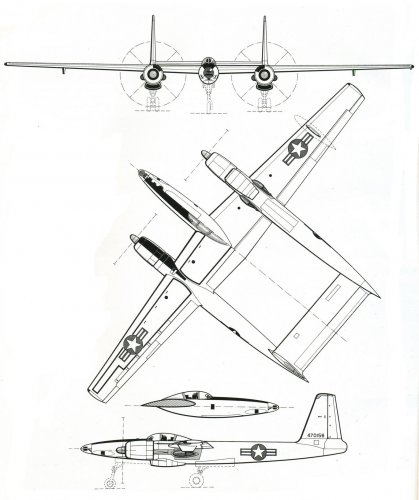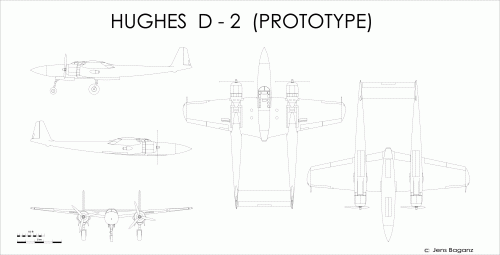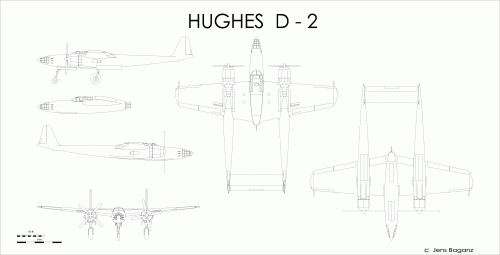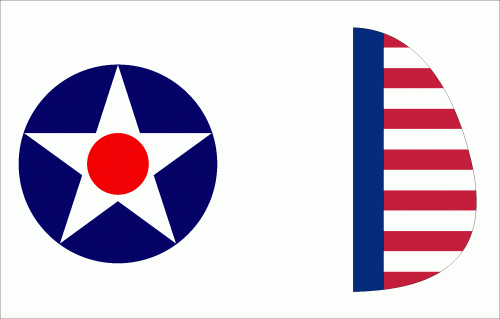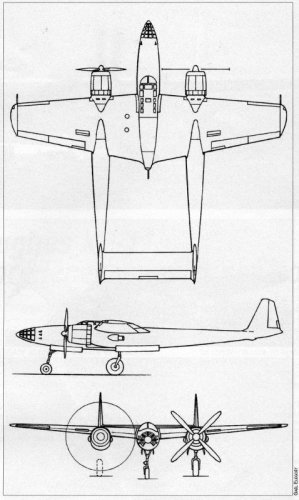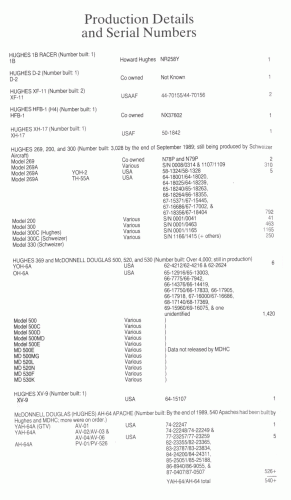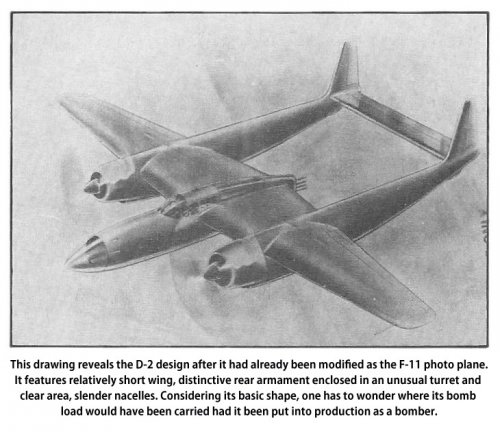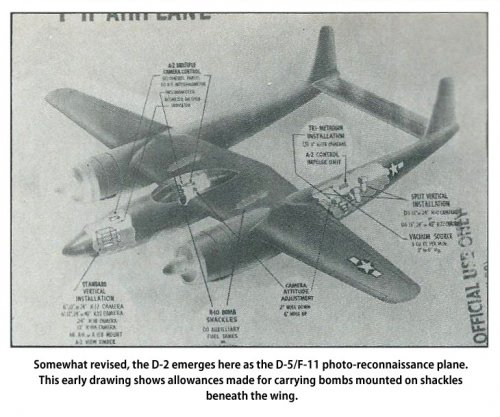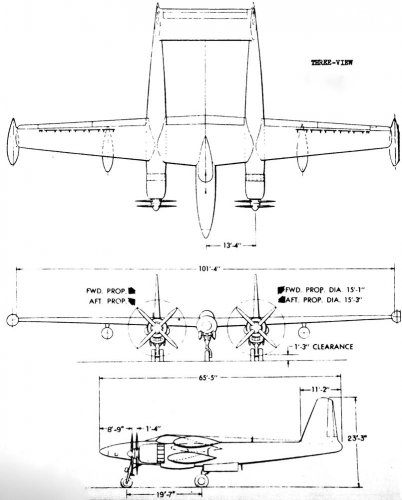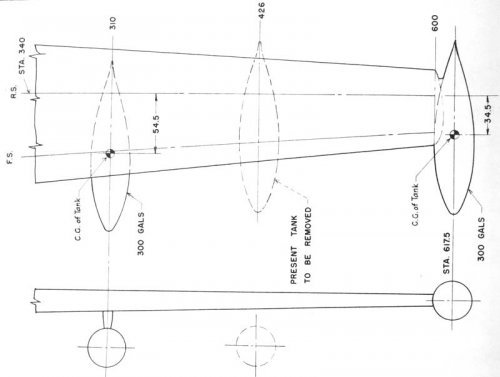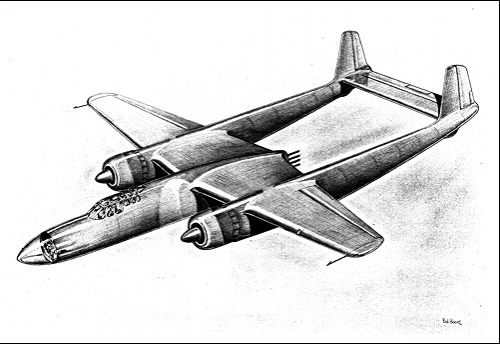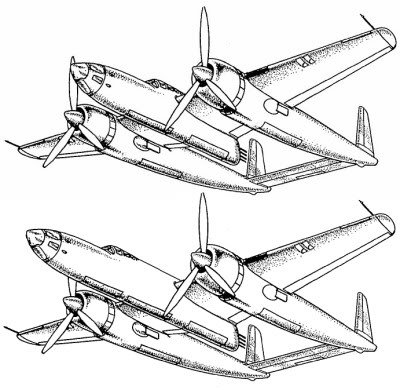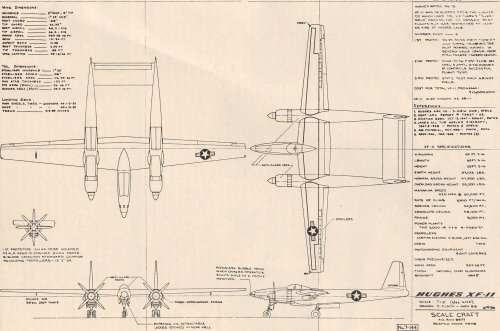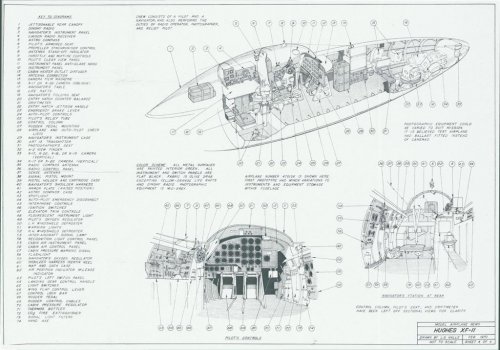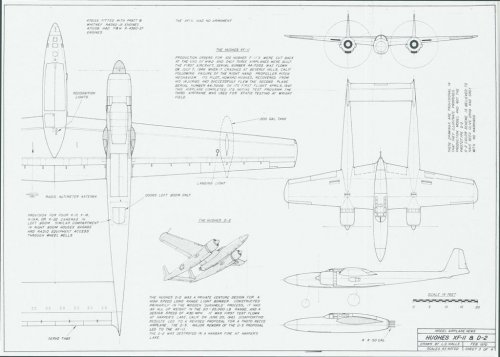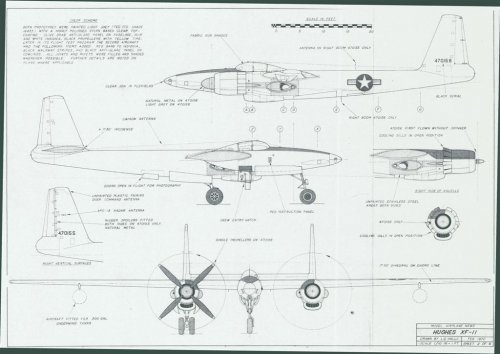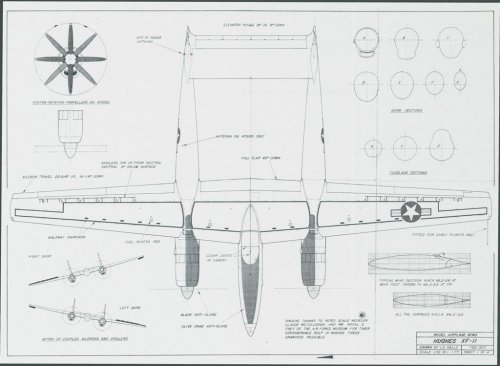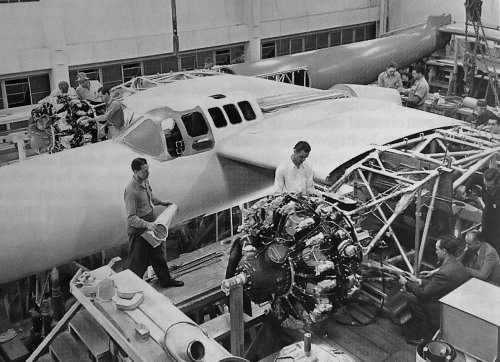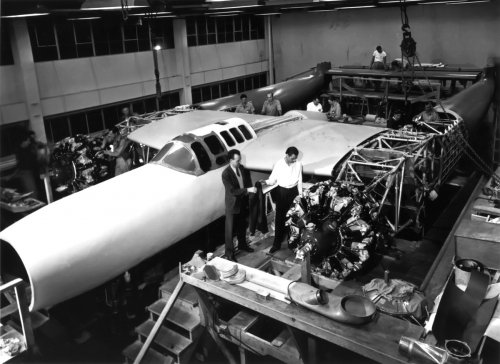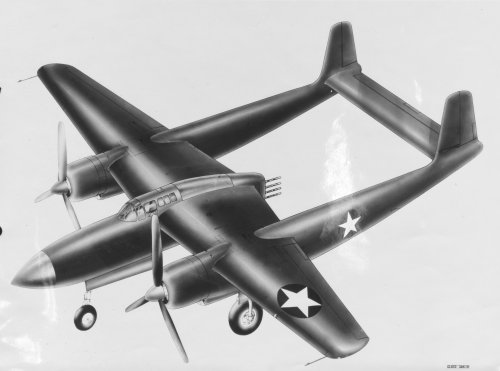You are using an out of date browser. It may not display this or other websites correctly.
You should upgrade or use an alternative browser.
You should upgrade or use an alternative browser.
Hughes D-2, D-5 and XF-11
- Thread starter XP67_Moonbat
- Start date
- Joined
- 11 March 2006
- Messages
- 8,609
- Reaction score
- 3,068
Re: Hughes D-2
Two drawings of the D-2 prototype and of the version with the glazed nose. Based largely on the posted
material, I omitted armament on the prototype, which additionally seems to have a slightly longer nose.
Two drawings of the D-2 prototype and of the version with the glazed nose. Based largely on the posted
material, I omitted armament on the prototype, which additionally seems to have a slightly longer nose.
Attachments
roadrunner2
ACCESS: Restricted
- Joined
- 26 July 2007
- Messages
- 39
- Reaction score
- 11
Re: Hughes D-2
fabubous drawin Jemiba, thanks
The 1st flight of the D2 held in june 43, the 20, so if he has national markings, they couldn't have a red disc.
for the color, this culd be interesting, no?
http://www.freewebs.com/aeroscale/huguesd2.htm
fabubous drawin Jemiba, thanks
The 1st flight of the D2 held in june 43, the 20, so if he has national markings, they couldn't have a red disc.
for the color, this culd be interesting, no?
http://www.freewebs.com/aeroscale/huguesd2.htm
- Joined
- 25 June 2009
- Messages
- 13,787
- Reaction score
- 3,095
Re: Hughes D-2
I personally would go for olive drab (we have seen the D-2A in metal everywhere before, so that would give it a nice operational feel).
As for the markings, you've picked the pre-1942 ones... The proposed DX-2 fighter and attack ("XA-37") variants were proposed in 1942. However, if produced and serviced, the D-2 would have gone straight into war — don't forget the brief "XP-73" allocation to the modified fighter proposal — so that makes it immediately prior to the Fisher P-75, therefore 1944-ish.
Jemiba said:Markings should be like below, I think ?
And what colour ? Can only think of metal or olive drab .
I personally would go for olive drab (we have seen the D-2A in metal everywhere before, so that would give it a nice operational feel).
As for the markings, you've picked the pre-1942 ones... The proposed DX-2 fighter and attack ("XA-37") variants were proposed in 1942. However, if produced and serviced, the D-2 would have gone straight into war — don't forget the brief "XP-73" allocation to the modified fighter proposal — so that makes it immediately prior to the Fisher P-75, therefore 1944-ish.
Re: Hughes D-2
There was an interesting article by René Francillon on the D-2 and XF-11 in Le Fana no.429. The author suggests that the D-2 was actually designed to set a new round-the-world flight speed record, faster than Hughes's own 1938 record on a Lockheed 14. Hughes apparently tried to sell the D-2 design to the military to obtain suitable engines and to get funds for this project.
According to the author, the aircraft was not well suited for military use. It was first proposed as a fighter (1939), then it appears in military reports as a bomber (1940) then an escort plane (1941). In 1942 it was a fighter again (XP-73) or an attack aircraft (XA-37), but the bomb bay was too small for an attack aircraft and it was not maneuverable enough for a fighter.
As for designations, the article says that the D-2 was sometimes indifferently called DX-2 or XD-2 by the military, and that the military evolution was perhaps called D-3 by the company.
Later the D-5 was an evolution with a new wing and a larger bomb bay, proposed in three versions as a reconnaissance aircraft, bomber or escort fighter. The reconnaissance version was built as the XF-11, later XR-11.
One last thing: I wonder if the H-1B racer, D-2, D-3 (?), H-4 Hercules and D-5 could possibly belong to the same designation system?
There was an interesting article by René Francillon on the D-2 and XF-11 in Le Fana no.429. The author suggests that the D-2 was actually designed to set a new round-the-world flight speed record, faster than Hughes's own 1938 record on a Lockheed 14. Hughes apparently tried to sell the D-2 design to the military to obtain suitable engines and to get funds for this project.
According to the author, the aircraft was not well suited for military use. It was first proposed as a fighter (1939), then it appears in military reports as a bomber (1940) then an escort plane (1941). In 1942 it was a fighter again (XP-73) or an attack aircraft (XA-37), but the bomb bay was too small for an attack aircraft and it was not maneuverable enough for a fighter.
As for designations, the article says that the D-2 was sometimes indifferently called DX-2 or XD-2 by the military, and that the military evolution was perhaps called D-3 by the company.
Later the D-5 was an evolution with a new wing and a larger bomb bay, proposed in three versions as a reconnaissance aircraft, bomber or escort fighter. The reconnaissance version was built as the XF-11, later XR-11.
One last thing: I wonder if the H-1B racer, D-2, D-3 (?), H-4 Hercules and D-5 could possibly belong to the same designation system?
Attachments
- Joined
- 25 June 2009
- Messages
- 13,787
- Reaction score
- 3,095
Re: Hughes D-2
Thanks a lot c460! This has to be the most accurate and detailed account I've ever read of the XR-11 chronology.

Thanks a lot c460! This has to be the most accurate and detailed account I've ever read of the XR-11 chronology.
That is certainly a very interesting hypothesis to work from!c460 said:One last thing: I wonder if the H-1B racer, D-2, D-3 (?), H-4 Hercules and D-5 could possibly belong to the same designation system?
- Joined
- 26 May 2006
- Messages
- 32,695
- Reaction score
- 11,957
Re: Hughes D-2
Hi C460,
the Hughes D-3 was developed in parallel with D-2,may be developed
from it,but no more details,please see;
http://en.wikipedia.org/wiki/Hughes_D-2
Hi C460,
the Hughes D-3 was developed in parallel with D-2,may be developed
from it,but no more details,please see;
http://en.wikipedia.org/wiki/Hughes_D-2
Numerous designations were given to the project, including D-2, DX-2, DX-2A, D-3, D-5, XA-37 and XP-73. The names reflected difficulties in development, shifting mission emphasis, and the USAAC's uncertainty over how to use the aircraft. In June 1942, a USAAF memorandum stated:
J
joncarrfarrelly
Guest
Re: Hughes D-2
Based on the description the Le Fana article has the same info as the D-2 chapter, pp. 52-58, of
Francillon's McDonnell Douglas Aircraft since 1920: Volume 2.
Jen's why would you represent a wood skinned aircraft in a metal finish?
Based on the description the Le Fana article has the same info as the D-2 chapter, pp. 52-58, of
Francillon's McDonnell Douglas Aircraft since 1920: Volume 2.
Jen's why would you represent a wood skinned aircraft in a metal finish?
- Joined
- 11 March 2006
- Messages
- 8,609
- Reaction score
- 3,068
Re: Hughes D-2
Indeed ! The mock-up looks dark on some photos and light on others and about the "metal finish" I was
probably fooled by this model : http://www.flickriver.com/photos/30794229@N02/tags/hughes/ :-\
joncarrfarrelly said:... Jen's why would you represent a wood skinned aircraft in a metal finish?
Indeed ! The mock-up looks dark on some photos and light on others and about the "metal finish" I was
probably fooled by this model : http://www.flickriver.com/photos/30794229@N02/tags/hughes/ :-\
Re: Hughes D-2
I was not aware that Hughes aircraft were covered in this volume. Does it have the H-1 and H-4 too? And perhaps later Hughes projects?
joncarrfarrelly said:Based on the description the Le Fana article has the same info as the D-2 chapter, pp. 52-58, of
Francillon's McDonnell Douglas Aircraft since 1920: Volume 2.
I was not aware that Hughes aircraft were covered in this volume. Does it have the H-1 and H-4 too? And perhaps later Hughes projects?
- Joined
- 25 June 2009
- Messages
- 13,787
- Reaction score
- 3,095
Re: Hughes D-2
The famous "Spruce Goose" is covered of course, stating that it started as the Hughes Kaiser HK-1 before being designated as both the H-4 and the HFB-1 (the latter has not often been quoted).
There is also a passage on the MA-1 electronic fire control system for the Convair F-106 as well as a page on Hughes' less-known work as a producer of ordnance and guns. Projects covered are the XH-28 flying crane, the Hughes 600X wide-body version of the Model 500.
The rest is pretty well-known, mostly the helicopters from the XH-17 to the Apache.
I'm attaching an excerpt from the production lists at the end of the book which shows only the Hughes-related types.
One chapter is devoted to Hughes. It tells the story of Howard Hughes, which is fairly well-known. Of particular interest is the info on the D-2. which states thatc460 said:I was not aware that Hughes aircraft were covered in this volume. Does it have the H-1 and H-4 too? And perhaps later Hughes projects?
The above information is especially interesting because it clearly states that there were three aircraft built AND flown: the D-2 prototype and the two XF-11 prototypes. Besides the already known XA-37 and XP-73 temporary designations, and though it fails to indicate that the XF-11 was redesignated as XR-11 in 1948, it mentions the F-11A designation for the planned production model (presumably changed to R-11A too)."the most mysterious project of the time was the private venture twin-engined D-2". "The twin-engined D-2 [was] initiated in great secrecy" by Howard Hughes "in preparation for a planned attempt at bettering his own round-the-world record". The D-2 "first flew in total secrecy at Harper's Dry Lake, California, on 20 June 1943". "Repeatedly Howard Hughes attempted to obtain government contracts for military derivatives of his high-speed, long-range D-2. He first succeeded in 1940 when the Army Air Corps authorized the development of the XA-37 five-seat attack bomber. Subsequently, work on the XA-37 was terminated and efforts were diverted to developing the D-2 into either a long-range fighter, for which the XP-73 designation appears to have been set aside, or a long-range, high-altitude reconnaissance aircraft. By then, the design had grown considerably both in size and weight but, on the power of two turbosupercharged Pratt & Whitney R-4360 engines, performance was sufficiently promising for the Army Air Forces to order two XF-11 reconnaissance prototypes and 100 production F-11As before the war's end. Howard Hughes was seriously injured when the first XF-11 crashed during its maiden flight on 7 July, 1946. Not yet fully recovered, Hughes determinedly and courageously made the first flight of the second XF-11 on 5 April, 1947." [...] "The second XF-11 was dropped from the Air Force inventory in November 1949".
The famous "Spruce Goose" is covered of course, stating that it started as the Hughes Kaiser HK-1 before being designated as both the H-4 and the HFB-1 (the latter has not often been quoted).
There is also a passage on the MA-1 electronic fire control system for the Convair F-106 as well as a page on Hughes' less-known work as a producer of ordnance and guns. Projects covered are the XH-28 flying crane, the Hughes 600X wide-body version of the Model 500.
The rest is pretty well-known, mostly the helicopters from the XH-17 to the Apache.
I'm attaching an excerpt from the production lists at the end of the book which shows only the Hughes-related types.
Attachments
- Joined
- 3 June 2006
- Messages
- 2,843
- Reaction score
- 2,547
Re: Hughes XF-11 and Variants
Link: http://www.aahs-online.org/journals/journal_template.php?vol_no=v55n3#Article 2
Picture: http://www.aahs-online.org/journals/jrnl_image.php?jrnl=v55n3&image=2Hughes engineering concept drawing of the D-5 bomber. (NARA)
Link: http://www.aahs-online.org/journals/journal_template.php?vol_no=v55n3#Article 2
- Joined
- 25 June 2009
- Messages
- 13,787
- Reaction score
- 3,095
Re: Hughes XF-11 and Variants
Not only you didn't ask for permission, hesham, but you even post the copyright infringement information... Takes some cheek! I don't think we should encourage such behaviors on the forum if the authors of the page expressly deny the free circulation of the material. The link provided previously was more than enough.
Not only you didn't ask for permission, hesham, but you even post the copyright infringement information... Takes some cheek! I don't think we should encourage such behaviors on the forum if the authors of the page expressly deny the free circulation of the material. The link provided previously was more than enough.
aliensporebomb
If it flies, it's probably interesting...
Re: Hughes XF-11 and Variants
That XF-11 for "The Aviator" sure was a beauty. Did anyone else think it was like someone took a P-38, streamlined it and then added the contrarotating props?
You have to wonder if he didn't joyride that thing into oblivion (and nearly himself) if that would have made production in numbers?
That XF-11 for "The Aviator" sure was a beauty. Did anyone else think it was like someone took a P-38, streamlined it and then added the contrarotating props?
You have to wonder if he didn't joyride that thing into oblivion (and nearly himself) if that would have made production in numbers?
Re: Hughes XF-11 and Variants
Blame the end of WWII for that.
MONTHLY MUNITIONS REPORT
The W-14 Plane Program
WAR PRODUCTION BOARD
Bureau of Program and Statistics
Military Division, Aircraft Branch
April 24, 1945
RECONNAISSANCE: SC-1 REPLACEMENT NEEDS RE-EVALUATED
The only reconnaissance plane now in production is the Navy SC-1 Seahawk. W-14 holds the current level of 58 planes a month through June 1945. After June, production will be lowered to a replacement level of 45 planes monthly (5 more than the estimated monthly needs shown in W-13R). The 1945 total is advanced 30 planes from 588 to 618.
Two new models have been further set back in W-14. Production of the experimental OSE-1 at Edo, College Point is expected to begin in November rather than June. At the request of the manufacturer (Hughes, Culver City), the Army's highly regarded F-11 was pushed back two months and production is to start in September. The F-11 is a two place monoplane specially designed for high altitude photo reconnaissance missions. It will have twin tail-booms, twin vertical fins, pressurized cabin and two R-4360 radial engines with two superchargers per engine. No guns or bombs are provided, but armor plate is provided for crew.
-----------
Aircraft Production Problems
For 1945
WAR PRODUCTION BOARD
Bureau of Program and Statistics
Military Division, Aircraft Branch
March 28,1945
Table in it says:
F-11
Hughes, Culver City
July 1945 (Production Start)
Nov. 1945 (Peak of Production)
High altitude photo reconnaissance plane; twin tail booms; pressurized cabin; R-4360 engines
-----------
MONTHLY MUNITIONS REPORT
W-14 Plane Program
Revised through May 25, 1945
F-11 RECONNAISSANCE PLANE CANCELLED
Because a long period of development would have been necessary to fit the F-11 for combat, the decision was made to cancel the program and to depend on reconnaissance versions of the Mustang, Lightning, Superfortress, etc. for Pacific war requirements. The Hughes F-11 is a high speed, high altitude plane with two R-4360 (3,000 hp) engines. In addition to design problems on the airframe, the R-4360 engine may require as much as a year's development before it is ready for combat.
There's a table showing that F-11 production under W-14 would have been 17 in 1945 and then 81 in 1946.
aliensporebomb said:You have to wonder if he didn't joyride that thing into oblivion (and nearly himself) if that would have made production in numbers?
Blame the end of WWII for that.
MONTHLY MUNITIONS REPORT
The W-14 Plane Program
WAR PRODUCTION BOARD
Bureau of Program and Statistics
Military Division, Aircraft Branch
April 24, 1945
RECONNAISSANCE: SC-1 REPLACEMENT NEEDS RE-EVALUATED
The only reconnaissance plane now in production is the Navy SC-1 Seahawk. W-14 holds the current level of 58 planes a month through June 1945. After June, production will be lowered to a replacement level of 45 planes monthly (5 more than the estimated monthly needs shown in W-13R). The 1945 total is advanced 30 planes from 588 to 618.
Two new models have been further set back in W-14. Production of the experimental OSE-1 at Edo, College Point is expected to begin in November rather than June. At the request of the manufacturer (Hughes, Culver City), the Army's highly regarded F-11 was pushed back two months and production is to start in September. The F-11 is a two place monoplane specially designed for high altitude photo reconnaissance missions. It will have twin tail-booms, twin vertical fins, pressurized cabin and two R-4360 radial engines with two superchargers per engine. No guns or bombs are provided, but armor plate is provided for crew.
-----------
Aircraft Production Problems
For 1945
WAR PRODUCTION BOARD
Bureau of Program and Statistics
Military Division, Aircraft Branch
March 28,1945
Table in it says:
F-11
Hughes, Culver City
July 1945 (Production Start)
Nov. 1945 (Peak of Production)
High altitude photo reconnaissance plane; twin tail booms; pressurized cabin; R-4360 engines
-----------
MONTHLY MUNITIONS REPORT
W-14 Plane Program
Revised through May 25, 1945
F-11 RECONNAISSANCE PLANE CANCELLED
Because a long period of development would have been necessary to fit the F-11 for combat, the decision was made to cancel the program and to depend on reconnaissance versions of the Mustang, Lightning, Superfortress, etc. for Pacific war requirements. The Hughes F-11 is a high speed, high altitude plane with two R-4360 (3,000 hp) engines. In addition to design problems on the airframe, the R-4360 engine may require as much as a year's development before it is ready for combat.
There's a table showing that F-11 production under W-14 would have been 17 in 1945 and then 81 in 1946.
Re: Hughes XF-11 and Variants
94 HI-RES HUGHES XF-11 PHOTOS AVAILABLE AT THE UNIVERSITY OF LAS VEGAS DIGITAL LIBRARY :
http://digital.library.unlv.edu/objects/hughes?CISOOP1=all&CISOFIELD1=CISOSEARCHALL&CISOROOT=%2Fhughes&CISOBOX1=XF-11&x=0&y=0
There are a total of 1688 digitized hi-res images of Hughes and its airplanes :
http://digital.library.unlv.edu/objects/hughes?CISOOP1=all&CISOFIELD1=CISOSEARCHALL&CISOROOT=%2Fhughes&CISOBOX1=&x=15&y=12
Hundreds of photos of the Spruce Goose here :
keyword : flying boat (280 photos)
http://digital.library.unlv.edu/objects/hughes?CISOOP1=all&CISOFIELD1=CISOSEARCHALL&CISOROOT=%2Fhughes&CISOBOX1=flying+boat&x=20&y=14
key word : spruce goose (60 photos, perhaps the same)
http://digital.library.unlv.edu/objects/hughes?CISOOP1=all&CISOFIELD1=CISOSEARCHALL&CISOROOT=%2Fhughes&CISOBOX1=spruce+goose&x=29&y=10
94 HI-RES HUGHES XF-11 PHOTOS AVAILABLE AT THE UNIVERSITY OF LAS VEGAS DIGITAL LIBRARY :
http://digital.library.unlv.edu/objects/hughes?CISOOP1=all&CISOFIELD1=CISOSEARCHALL&CISOROOT=%2Fhughes&CISOBOX1=XF-11&x=0&y=0
There are a total of 1688 digitized hi-res images of Hughes and its airplanes :
http://digital.library.unlv.edu/objects/hughes?CISOOP1=all&CISOFIELD1=CISOSEARCHALL&CISOROOT=%2Fhughes&CISOBOX1=&x=15&y=12
Hundreds of photos of the Spruce Goose here :
keyword : flying boat (280 photos)
http://digital.library.unlv.edu/objects/hughes?CISOOP1=all&CISOFIELD1=CISOSEARCHALL&CISOROOT=%2Fhughes&CISOBOX1=flying+boat&x=20&y=14
key word : spruce goose (60 photos, perhaps the same)
http://digital.library.unlv.edu/objects/hughes?CISOOP1=all&CISOFIELD1=CISOSEARCHALL&CISOROOT=%2Fhughes&CISOBOX1=spruce+goose&x=29&y=10
Steve Pace
Aviation History Writer
- Joined
- 6 January 2013
- Messages
- 2,266
- Reaction score
- 168
Re: Hughes XF-11 and Variants
Great Stuff - Thanks! -SP
Great Stuff - Thanks! -SP
- Joined
- 17 May 2008
- Messages
- 676
- Reaction score
- 1,330
Re: Hughes XF-11 and Variants
Hughes proposed a modification to the XF-11 to improve the speed and range of the aircraft. The proposal was titled XF-11 Modification A. The direct change of the proposal was to increase the fuel capacity of the aircraft by 1200 gallons and an increase in engine horsepower.
Modification A would increase the internal wing tank capacity by 600 gallons and add two 300 gallon each wing tip tanks. The under wing 300 gallon external tanks would be retained as well. The P&W R-4360-31 engines would be replaced by the more powerful R-4360-43 engines. The goal was an increase in maximum speed to 489 mph and a maximum range of 6390 miles.
Attached are a general arrangement of the Modification A showing the additional wing tip tanks and a more detailed view of the wing showing the revised location of the external fuel tanks.
NARA II RG341
Hughes proposed a modification to the XF-11 to improve the speed and range of the aircraft. The proposal was titled XF-11 Modification A. The direct change of the proposal was to increase the fuel capacity of the aircraft by 1200 gallons and an increase in engine horsepower.
Modification A would increase the internal wing tank capacity by 600 gallons and add two 300 gallon each wing tip tanks. The under wing 300 gallon external tanks would be retained as well. The P&W R-4360-31 engines would be replaced by the more powerful R-4360-43 engines. The goal was an increase in maximum speed to 489 mph and a maximum range of 6390 miles.
Attached are a general arrangement of the Modification A showing the additional wing tip tanks and a more detailed view of the wing showing the revised location of the external fuel tanks.
NARA II RG341
Attachments
- Joined
- 26 May 2006
- Messages
- 32,695
- Reaction score
- 11,957
Re: Hughes XF-11 and Variants
Can I put it again.
hesham said:Very cool my dear Fightingirish,
and we can display it here.
Attachement removed, see below.
Can I put it again.
Attachments
FOUND IN
NARA II, COLLEGE PARK
RECORD GROUP 250
ENTRY 36 – FRED SEARLS
DECLASSIFIED VIA NND 730024
March 13, 1945
AIRCRAFT PRODUC.
MEMORANDUM TO FILES
Photographic Plane F-11 & XF-11
I went with Colonel McManmon to talk to General Giles and General Echols at 4.00 p.m. on March 12th, concerning the need for this plane and production plant. They were generally familiar with the criticism of the Bureau of the Budget.
The most important point developed was that the contract of the AAF with the Hughes Tool Company is an Upset-Price contract, and not Cost-Pius or Cost-Plus-Fixed-fee; so that there apparently would not be any particular benefit to Hughes to charge labor actually engaged on the HK-1 project to the F-11 project, or vice versa. The Budget report rather leaves the inference that there might be an advantage to the contractor in such diversion.
Gen. Giles said they had real need for a photographic plane; and that when this design of Hughes was accepted, they calculated that they did not have time to develop a totally independent design, and the Hughes plane had been developed to a point where one had actually been built. This he inspected and examined carefully, spending a whole day on it, although he did not fly it.
Gen. Giles said they were cognizant of Hughes' inexperience in production and got him an experienced airplane production engineer from Consolidated—a man with an Italian name, which I can not remember. They thought that Hughes was competent to make one, two, or three planes, and that this man that they provided would enable him to get it into production.
At that time, much pressure was being put on procurement agencies to keep contracts off the Pacific Coast. With some qualms, they agreed to the sub-contracting of the wings to the Fleetwings plant. They admit that it is slow and inefficient. They infer that if they had to do it over again, they would not have consented to this sub-contract; but that on recent pressure from the WPB and War Manpower Commission to change, Hughes insists that they accept a three-months' delay and pay all costs of a change to a Pacific Coast contractor.
They do not regard the development cost of $13 million for the three experimental planes as out of line with their experience with other plane development. They say that the cost of subsequent production of $447,000 is also reasonable, having in view the small number of planes; but that if additional planes were to be made, this cost would come down very materially. B-29 costs have come down about 50% after the first 100 were made, Some of the costs of the B-29 are now down as low as $257,300, without allowance for G.F.E.
This plane is supposed to be good for 450 miles an hour and have nearly the range of B-29's. They believe it will be more satisfactory than converted bombers (B-24's or B-29's) now being used.
They regret that this plane happens to be mixed up in the Hughes plant with the HK-1 Flying Boat, which they predict will be a failure and think should be cancelled now. They wish to continue with the contract with Hughes, and also the sub-contract with Fleetwings. They are disappointed at the delays, but do not think improvement can be had in moving the contract elsewhere. They claim to be willing to take full responsibility; and said that if there is ever an investigation of the Hughes-Kaiser relations, they can show that their procedure is defensible. They intimated that what ever amateur ideas might have originally gotten into the design had been checked, and either approved or eradicated by thorough going over of the designs at Wright Field.
I left the meeting at 4.30, feeling that the Generals had been frank and truthful. I do not feel that the contract was very wisely handled and believe the sub-contract was particularly objectionable; but believe there is a need for the planes, that there was nothing scandalous in the procedure, and that it is too late to make beneficial changes--if the contracts are to be continued.
Fred Searls, Jr.
FS:imd
NARA II, COLLEGE PARK
RECORD GROUP 250
ENTRY 36 – FRED SEARLS
DECLASSIFIED VIA NND 730024
March 13, 1945
AIRCRAFT PRODUC.
MEMORANDUM TO FILES
Photographic Plane F-11 & XF-11
I went with Colonel McManmon to talk to General Giles and General Echols at 4.00 p.m. on March 12th, concerning the need for this plane and production plant. They were generally familiar with the criticism of the Bureau of the Budget.
The most important point developed was that the contract of the AAF with the Hughes Tool Company is an Upset-Price contract, and not Cost-Pius or Cost-Plus-Fixed-fee; so that there apparently would not be any particular benefit to Hughes to charge labor actually engaged on the HK-1 project to the F-11 project, or vice versa. The Budget report rather leaves the inference that there might be an advantage to the contractor in such diversion.
Gen. Giles said they had real need for a photographic plane; and that when this design of Hughes was accepted, they calculated that they did not have time to develop a totally independent design, and the Hughes plane had been developed to a point where one had actually been built. This he inspected and examined carefully, spending a whole day on it, although he did not fly it.
Gen. Giles said they were cognizant of Hughes' inexperience in production and got him an experienced airplane production engineer from Consolidated—a man with an Italian name, which I can not remember. They thought that Hughes was competent to make one, two, or three planes, and that this man that they provided would enable him to get it into production.
At that time, much pressure was being put on procurement agencies to keep contracts off the Pacific Coast. With some qualms, they agreed to the sub-contracting of the wings to the Fleetwings plant. They admit that it is slow and inefficient. They infer that if they had to do it over again, they would not have consented to this sub-contract; but that on recent pressure from the WPB and War Manpower Commission to change, Hughes insists that they accept a three-months' delay and pay all costs of a change to a Pacific Coast contractor.
They do not regard the development cost of $13 million for the three experimental planes as out of line with their experience with other plane development. They say that the cost of subsequent production of $447,000 is also reasonable, having in view the small number of planes; but that if additional planes were to be made, this cost would come down very materially. B-29 costs have come down about 50% after the first 100 were made, Some of the costs of the B-29 are now down as low as $257,300, without allowance for G.F.E.
This plane is supposed to be good for 450 miles an hour and have nearly the range of B-29's. They believe it will be more satisfactory than converted bombers (B-24's or B-29's) now being used.
They regret that this plane happens to be mixed up in the Hughes plant with the HK-1 Flying Boat, which they predict will be a failure and think should be cancelled now. They wish to continue with the contract with Hughes, and also the sub-contract with Fleetwings. They are disappointed at the delays, but do not think improvement can be had in moving the contract elsewhere. They claim to be willing to take full responsibility; and said that if there is ever an investigation of the Hughes-Kaiser relations, they can show that their procedure is defensible. They intimated that what ever amateur ideas might have originally gotten into the design had been checked, and either approved or eradicated by thorough going over of the designs at Wright Field.
I left the meeting at 4.30, feeling that the Generals had been frank and truthful. I do not feel that the contract was very wisely handled and believe the sub-contract was particularly objectionable; but believe there is a need for the planes, that there was nothing scandalous in the procedure, and that it is too late to make beneficial changes--if the contracts are to be continued.
Fred Searls, Jr.
FS:imd
roadrunner2
ACCESS: Restricted
- Joined
- 26 July 2007
- Messages
- 39
- Reaction score
- 11
- Joined
- 25 June 2009
- Messages
- 13,787
- Reaction score
- 3,095
Very interesting stuff! Thanks a lot RyanCrierie and roadrunner2.
This reports speaks tons on the inadequate management methods of Howard Hughes. I find the following bits particularly revealing:
This reports speaks tons on the inadequate management methods of Howard Hughes. I find the following bits particularly revealing:
There has been a laxity in cost control and accuracy due to scrambled facilities, labor usage, and other contract operations being performed at the plant.
At present the contractor has no adequate timekeeping system that will accurately segregate the specific time spent by each employee on the various types of contracts now in force at this plant.
The contractor changed management in September 1944 and the new general manager, a former Consolidated Vultee employee, believes that while the old organization was experimentally minded to a fault, it will not be too difficult to correct. The AAF representative believes more progress should be made toward obtaining a more productively minded organization.
They intimated that what ever amateur ideas might have originally gotten into the design had been checked, and either approved or eradicated by thorough going over of the designs at Wright Field.
Vladimir
I really should change my personal text
- Joined
- 22 September 2015
- Messages
- 321
- Reaction score
- 37
roadrunner2 said:some plan.
Thanks, roadrunner
ZacYates
LHX SuperTeam fanboy
- Joined
- 26 December 2012
- Messages
- 149
- Reaction score
- 123
I just love seeing all the plans, drawings etc uploaded over the last three or so months. Awesome stuff! It makes it a lot easier for folks, like myself, wanting to build models of the D-2/F-11 in sercvice etc.
- Joined
- 26 May 2006
- Messages
- 32,695
- Reaction score
- 11,957
ZacYates said:I just love seeing all the plans, drawings etc uploaded over the last three or so months. Awesome stuff! It makes it a lot easier for folks, like myself, wanting to build models of the D-2/F-11 in sercvice etc.
Hi Zac,
I think a build models for them well be great.
Vladimir
I really should change my personal text
- Joined
- 22 September 2015
- Messages
- 321
- Reaction score
- 37
The Hughes D-2 under construction at the Hughes Airport in Culver City, California. Hughes can be seen looking over the engine installation and near Glenn Odekirk, Hughes’ mechanic, engineer, and assistant.
Attachments
Found in the Library of Congress, William Patterson Papers in the Manuscript Division.
Also nearby was a complete cost breakdown for the D-2 by Hughes.
Apologies for the glare on the image; this was taken with a really expensive book scanner at the Manuscript Division and not with a flatbed scanner. :-\
Also nearby was a complete cost breakdown for the D-2 by Hughes.
Apologies for the glare on the image; this was taken with a really expensive book scanner at the Manuscript Division and not with a flatbed scanner. :-\
Attachments
Similar threads
-
-
-
-
Hughes Aircraft Company XAAM-N-11 model
- Started by Triton
- Replies: 0
-
ASD Preliminary Designs in Splendid Vision, Unswerving Purpose
- Started by XP67_Moonbat
- Replies: 16

